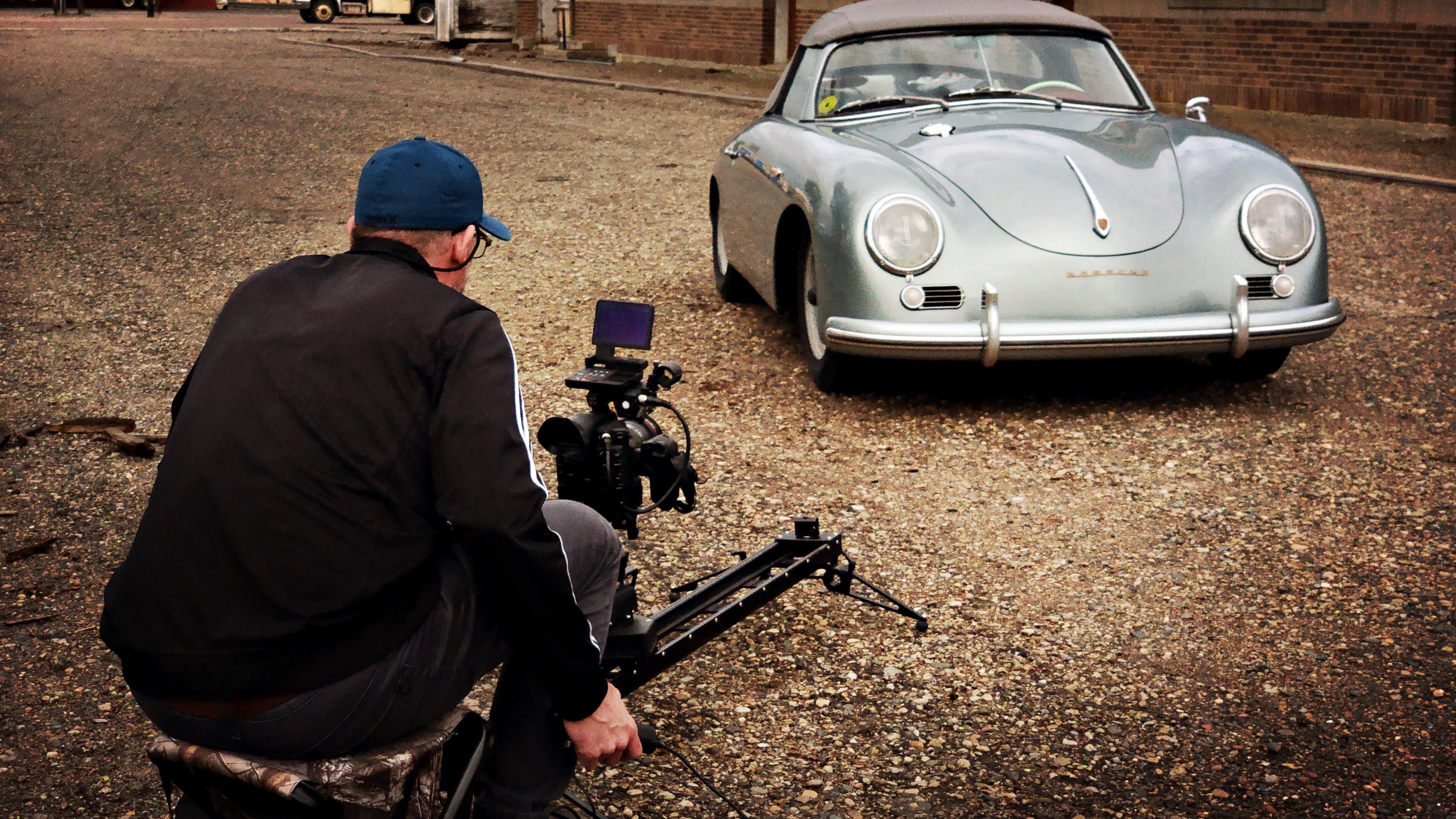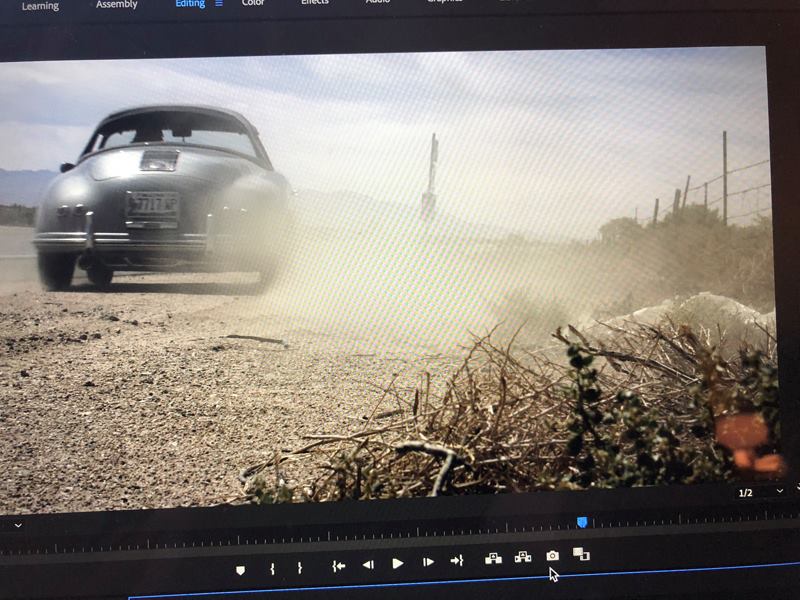
The Real 356: An investigation into Ways to Live
I have been bothered for a while trying to understand verbally what makes a car a “real” 356. Is it a vin. number? Is it the COA? Is it matching number body panels, engine and transmition numbers? Is a replica, a real 356? Does it have to be made by Porsche? What if over 50% of the parts are NOS Porsche but the rest isn’t? What if it started as a rusted lawn planter and you replaced everything with fake parts but have a good vin. number and a COA? What makes it a real 356? And why are real 356s so appealing where as fakes are not? And then it hit me . . .
A real 356 is an emotional feeling. It comes from a certain smell, a feel to the Reutter seat, The rough wool carpet against your palm, the way the machine slots down a curvy road at speed, the delighted wail of the air-cooled 4, the thin hard wheel in your hands, the way nature seems to be in the car as much as around it (Amanda said it was basically a motorcycle on four wheels). And most important—the way the moment seems to be in your heart. It is a rare state of being alive and being in an object that you know is amazingly beautiful and near perfection. And this is why James Dean, Steve McQueen, and Marshall Green, my father, loved them. These were really cool handsome guys, cool because they were sensitive and compassionate, and also fearless and tough as hewn oak, and they wanted a ride that matched them. In tandem with the perfect machine, they knew what was possible! The immaculate glory and emotion of the open road.
I have it worse than most. I was conceived in one of those Reutter passenger seats according to my mother, who freely offered all the information I really didn’t want to hear. My first memory was as a baby looking up out of my basket placed on the folded down rear seats, looking up through the rear glass of that 1952 coupe at the rain being carelessly illuminated by the streetlights of my hometown, Gorham, New Hampshire, 1958 likely when I was two. It was being beaten up about every week at school in Massachusetts because I dared to defend the value of my father’s then 1961 356B coupe. Porsches were distained or worse hated: “Upside-down bathtub, fancy Volkswagen Bug, Nazi piece of shit.” That although the Austrian Komenda had designed the body. Americans didn’t like them mainly because they didn’t have the patience or intelligent skill to maintain and repair them correctly. They required a new way of thinking, and too many Americans can be obnoxiously inflexible and ignorant.
In the fall of 1975, I was walking along a Brown University hallway in Providence, Rhode Island when I was inexplicably drawn to a hand-written file card tacked to a bulletin board. It read:
1956 Porsche 356A 1600S For Sale.
$1,400
Without any logic or good sense I decided I had to purchase that very car. I had been living above Duke’s Poolroom, sleeping on the floor in a tattered black raincoat I had bought in a general store on Isleboro, Maine for a dime. I had been near starving, scouring the bleak windy streets for lost change, hustling pool when I had any money to hustle with, too proud to beg. I was seventeen years old but would turn eighteen on December 1stand my father owed me $1,500 he had borrowed, money I’d made selling paintings. But he finally return the debt, and I bought that very 356 eight days after my birthday and promptly drove it over 30 hours west through heavy snows and 10 below zero in Cleveland, Ohio without any heat in the cockpit, and I had the 356 bug in me forever. I had discovered—the feeling, the magical illusiveit. A feeling that only comes from a 356. And my 356A was as my father impolitely pointed out to me—a junker. Still, the junker got me across America many times, and through New England with a style that can’t be rivaled. The car makes you cool although I never realized it at the time. For me it was simply in my blood, and as I always said, if the 356 is running correctly, it’s as if our two fluids are joined, her oil in my veins, and my blood in hers. That is a real356.
But . . .
After driving through 5 hours of blizzard in 1978, I had to take the old Stage Coach Road in northern Vermont because I dreamed I was Stirling Moss, or could drive like Stirling Moss, my only hero (stupidly, I found myself still doing this just months ago), and the road hadn’t been plowed in at least an hour. And on the final hill, forced to driving at near 55 mph just to maintain momentum through the deep snow, as I took the final down slope, now reveling in the fact I had actually made it to my parent’s rental home once I reached the bottom of the hill, the 356 nosed into a major drift and began to sled or toboggan on the pan, and it dropped very gently over a slight ravine and headed at growing speed toward a 1 acre open field. There was no controlling the car—no steering, no brakes, nothing. And in the center of that field was one 100 year old oak post. Nothing else but that one post. And like a fucking magnet that had been waiting 100 years for my beautiful 356 junker . . . yup! Perfect dead center collision cutting off the post.
I ran through the snow crying, the tears freezing, and I couldn’t bear that I had wrecked the thing I loved most. Sold her and bought a 122S with a P-1800 racing engine. But it would not be the same again—or so I thought. And every damn year I watched the prices of 356s rise as my art career did nothing. At 40k for a good one, I threw in my garage rag and gave up. Yet . . . the Celt doesn’t quit easily. Who else would slave every day for 45 years without any recognition or even a paycheck?
Then, after 45 years of being ignored, suddenly sales of my work rocketed. The first show titled Time Diptychs earned a quarter of a million dollars, and that was just the beginning. It soon enough dawned on me I could buy anything Porsche except a good original 550 Spyder and a few of the rare 356 Carreras.
But . . .
I had harbored a fantasy all my life. It was to do what my father did, and order a custom made early 356 just as I wanted it. Every color, every fabric, every curve, every single thing would be exactly as I dreamed it, and believe me, I knew exactly what I craved having had 40 years to consider it. And I realized with surprise that the last thing I wanted was another old worn out 356, or paying for a restoration and relying on someone else’s honesty to fulfill my dream. It was after all—my dream. I thought of Rod Emory, and he would’ve been a reasonable choice, but I believed I could figure another way. And I did. And the last thousand miles my wife Amanda and I took from Belfast, Maine to the north shore of Prince Edward Island was perfect. Simply a dream come true, and it was WAY better than I ever imagined. It was the full 356 experience times . . . you pick a number. It was it.
Which brings me to the new breed of owner, the ones with the 100 point restorations, the numbers matching trailered, pampered gorgeous Carreras that are started maybe once a year with great trepidation. And they stand next to their gloriously polished machines on manicured lawns with other like-minded folks, and grin because they think the have something special. To me you look like those pathetic misguided idiots who have their photo taken with the lion they have slain, their ugly expensive boot on the lion’s head, holding some ridiculously powerful firearm. (Let’s go in the woods together. We will each have an ancient recurve bow and 6 hunting arrows. Then we will will find out who you are.) And the new 356 owners have come to the party too late, ruined it for the rest of us, and have missed the entire point of why a 356 is so wonderful, and why James Dean and Steve McQueen and Marshall Green loved them so much. I have one bit of advice:
Get in the damn perfect Carrera and drive it as fast as you can (or faster than you can) on only back roads across America and maybe, maybe, just for one brief moment you might get a glimpse of what the poetry of the 356 moment is, and how that machine is one giving fucking enabler. It is not a trophy to hang on your wall with the lion’s head and the woman who likely married you for the wrong reason and is now realizing she is paying for every cent. Seriously—go do it now. You will thank me!

